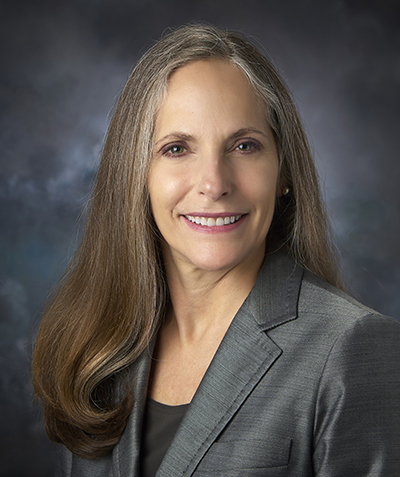Dean's Update 2023-08
August 29, 2023
OMM plays a crucial role in osteopathic medicine’s holistic foundation of serving the patient
Osteopathic medicine’s holistic focus is found in the tenets of the profession, beginning with Osteopathic Manipulative Medicine and its ability to help the body to heal itself.
Earlier this month, we celebrated the birthday of the founder of osteopathic medicine, Andrew Taylor Still, recognizing the physician’s vision and desire to improve the medical profession. We celebrate Dr. Still’s work, resulting in the Doctor of Osteopathic Medicine degree.
It is fitting then to talk about one of the pillars of osteopathic medicine – Osteopathic Manipulative Medicine (OMM) – the application of manual pressure or force used to treat areas of the body, including bones, joints, tissues and muscles, to help restore functionality and better understand the underlying causes for pain and illnesses.
Lisa DeStefano, D.O., professor-Health Programs in the MSU College of Osteopathic Medicine Department of OMM, explains that OMM looks at the human condition from an osteopathic perspective and determines whether manipulation will be used in treatment. At the same time, the D.O. will take into consideration other health issues. Then a plan is made, which may or may not include medication and Osteopathic Manipulative Treatment (OMT) – the OMM approach to treating the patient.
Dr. DeStefano will offer details and provide more explanation about OMM and OMT in our profession and within the Michigan State University College of Osteopathic Medicine.
Lisa DeStefano, D.O.
Osteopathic medicine is based on a functional model, meaning D.O.s are taught how the body functions – the human functions, biological functions – not focused only on dise ase. “My education allowed me to learn how to decipher a disease and how to understand the disease. In addition, I was taught the role of the musculoskeletal system for diagnosing disease,” Dr. DeStefano explained.
ase. “My education allowed me to learn how to decipher a disease and how to understand the disease. In addition, I was taught the role of the musculoskeletal system for diagnosing disease,” Dr. DeStefano explained.
Understanding the musculoskeletal system is important, and to understand it, physicians also need to know the neurology, connected tissue, mechanics and biomechanics. “Each joint – elbow, hip, finger, joints along the spine – make up a kinetic chain,” Dr. DeStefano explained. “In addition, the joint capsule around it is passive and maintains the joint, but there is also neurology in the joint that sends a signal to spinal cord. Understanding how all of this is working together to maintain joint connection and movement is important.”
Physicians can better help patients with back pain, knee pain or other joint pain by identifying the root cause of the pain. OMT is not just about manipulating joints to relieve pain; it's about treating the underlying issue causing the pain. For example, when a patient has knee pain, the physician will examine the pelvis, ankle and spine to determine the cause of the pain. Treating only the knee without addressing the larger issue is not effective.
“OMT is what we use to maintain the integration of the muscles, joints and nerves which all work to stabilize the spine,” Dr. DeStefano said.
She notes that OMT is not a cure-all, but it can be helpful, especially when used early to treat back pain. Treating patients with low back pain early on may reduce opioid use and save health costs from unnecessary imaging.
Many of these patients locally are referred to D.O.s at the Osteopathic Manipulative Medicine Clinic – East Lansing, in the Eyde Building. MSU has the largest OMM clinic in the country where 27,000-30,000 patient care visits are handled each year. “It’s the largest free-standing OMM clinic in the country,” Dr. DeStefano said.
This is where Dr. DeStefano and her colleagues serve patients. When OMM treatments are begun as symptoms and signs are first seen, it can help patients avoid further disease, such as arthritis and end up with degeneration of the disk. “If we can catch it early on and teach good habits, like how to stretch, how not to stretch, we can help people maintain their health and it would be a huge cost savings,” Dr. DeStefano said. As an example, a patient in his early 50s who is a runner was doing weightlifting and started getting lower back pain. He was doing particular destabilizing back stretches when he really needed to stretch his hip flexors and strengthen his abdominal muscles so he could continue running.
Even patients with severe problems may gain time with OMT. A patient who was a firefighter and had an unstable low lumbar spine who had seen a surgeon was told she would need a fusion. She didn’t want to have the fusion while still working and became a regular OMM Clinic patient. Following retirement, the patient went into nursing and still has not had the fusion, Dr. DeStefano said, calling it a win.
“Our job is to educate to help patients understand their pain,” Dr. DeStefano said. “We use manipulation to help them to move better, without pain. This encourages them to move more, stretch, maintain self-care, and gives them accountability for how they feel.”
In part, it’s about being seen and heard, Dr. DeStefano said, adding, “We have everything we need in the human body to live into our eighth decade without arthritis, hip replacement, joint replacement and surgery. Spine health is critical – as critical as a good diet, blood pressure medications and maintaining your weight. Spine health is important for longevity.”
As we continue to support patients in all walks of life with a variety of health needs, the MSU College of Osteopathic Medicine continues to teach our medical students about OMM and OMT and where it fits within the medical field as we take an osteopathic, holistic approach to serving our patients.

Andrea Amalfitano, D.O., Ph.D.
Dean
Lisa DeStefano, D.O.
Professor of Health Programs
Department of Osteopathic Manipulative Medicine
